Number 13
HIMALAYAS PLUS
MARCH-APRIL 2025
Dear All,
Greetings from the Centre of Excellence for Himalayan Studies, SNIoE. We are delighted to present the 13th edition of our Newsletter covering the months of March and April 2025. This and previous Newsletters are also available on our website.
PUBLICATIONS
We published two Commentaries in this period. The first one authored by CHS Post-Doctoral Fellow, Dr Rinan Shah, highlighted the importance of springs in ensuring water security in the Himalayan region, and the need to engage mountain communities in creating administrative-legal frameworks to sustain them.
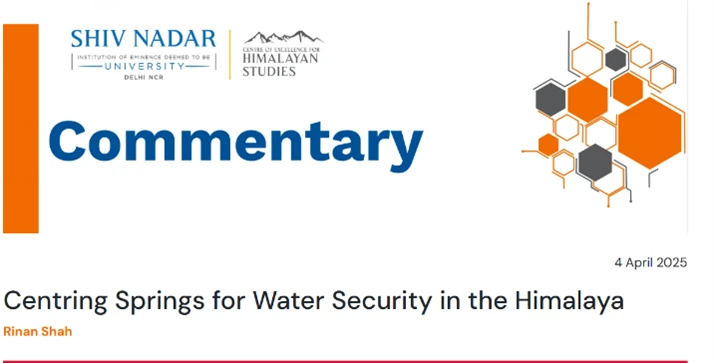
The second Commentary authored by Dr Mirza Zulfiqur Rahman, Visiting Associate Fellow, Institute of Chinese Studies, Delhi, looked at the effects of dam building on Brahmaputra by both China and India on lower riparian, Bangladesh. As a way out of the current tensions and in view of climate change, he calls for developing planetary approaches to development projects in the region.
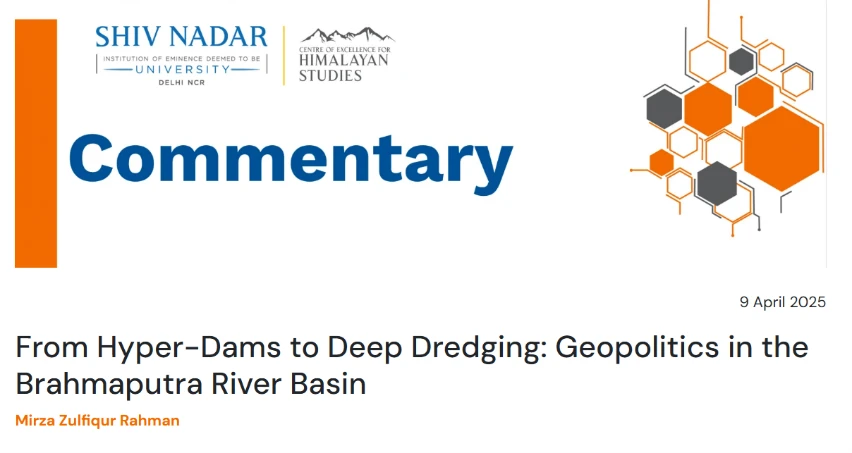
CHS Post-Doctoral Fellow, Dr Rinan Shah co-authored a paper, ‘Hits and misses: water-based climate change adaptation interventions for agriculture in South Asia' in the Global Change journal. CHS Post-Doctoral Fellow, Dr Sangay Lachenpa published a paper titled, ‘China's Development Model in Tibet: Positioning Shifts in its Strategy’ in the Tibet Policy Journal, Vol. XI, No. 2, 2024.
CHS Non-Resident Senior Fellow, Dr Kalzang Dorjee Bhutia co-edited an open-access book On the Significance of Religion in Climate Change published by Routledge in March 2025, and, co-authored an article titled, ‘Interdimensional Hazards in Museum Collections: Encountering the Gosum at MAA’ for MAA Digital Lab on 4 March 2025.
Our researchers also contribute to other platforms, and you can find a selection of these writings on the CHS website.
EVENTS
On 20 March, CHS, in collaboration with the IRGS Department, organised a webinar on the theme ‘Bringing Glaciers to New Delhi’s Attention: An Interdisciplinary Dialogue on the Himalayan Cryosphere’, which facilitated conversations on climate, policy, and science related to Himalayan glaciers. CHS Post-Doctoral Fellow, Dr Rinan Shah, was one of the panelists in the event. This discussion was an official side-event of the UN-Glaciers International Year for Glaciers’ Preservation, implemented by UNESCO and the World Meteorological Organization; and is listed on the UN Glaciers platform.
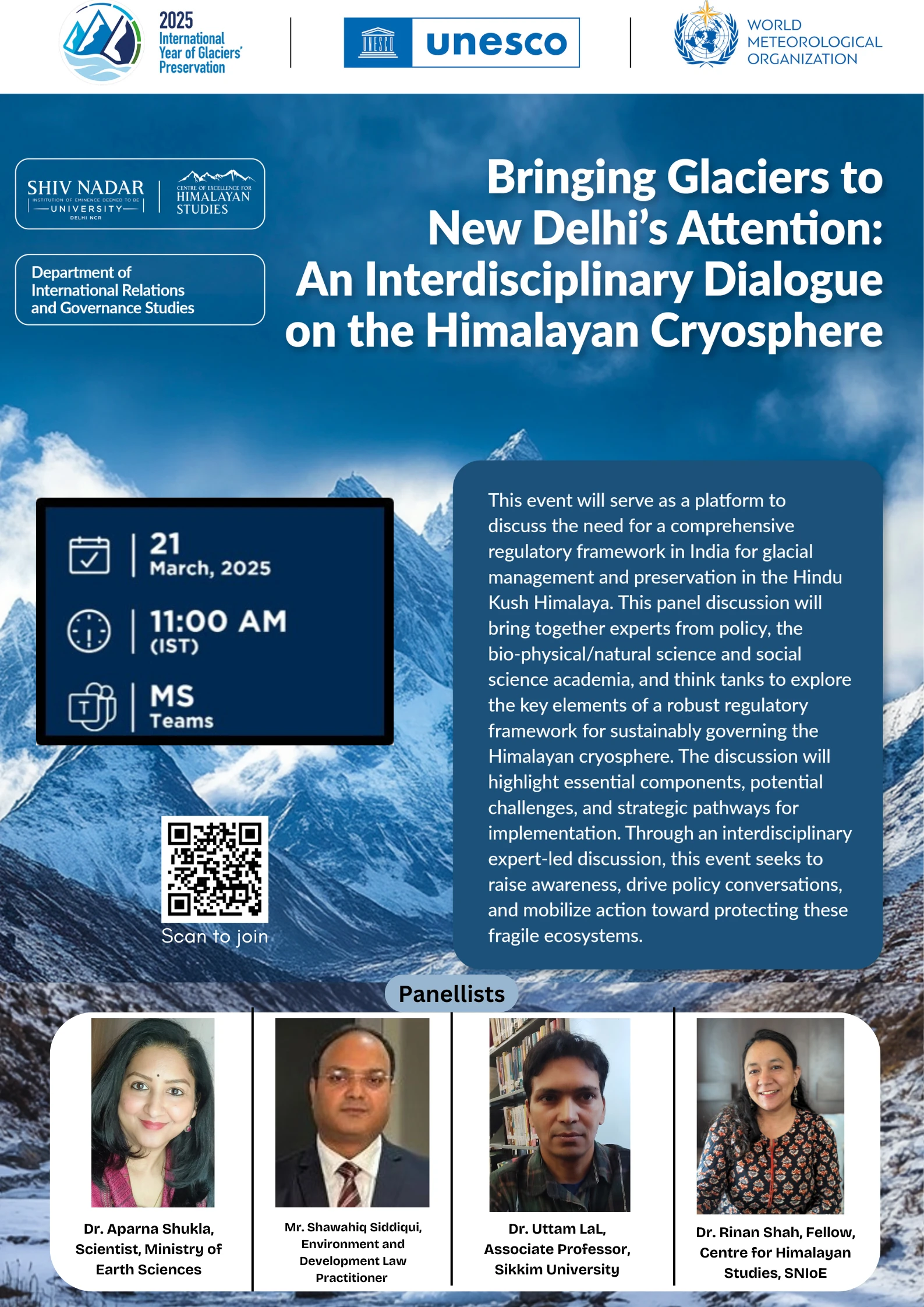
IN THE MEDIA
CHS Director, Dr Jabin T. Jacob authored multiple pieces. Writing for India’s World he notes that China’s “community with a shared future” rhetoric masks a hierarchical world order with China on top. In a piece for the Deccan Herald, he notes how notwithstanding strong trends of centralisation, provinces are critical entities in foreign policy engagement for China, and the lessons this approach holds for India. In another piece for the Deccan Herald, he argues that with Trump’s tariffs kicking in, China will increase pressure on countries to keep their markets open. For the Hindustan Time he notes two structural problems – the boundary dispute and the US factor – that will continue to be a source of tensions in the India-China relationship despite the recent thaw.
CHS Distinguished Fellow, Mr Claude Arpi contributed multiple opinion pieces to Firstpost in March and April. He wrote on how Indian soldiers defied overwhelming odds in 1962, and on the historical records in Lohit Valley that challenge China’s present-day territorial claims and narratives. In another piece he notes how China’s rhetoric on unity masks repression, exemplified by a Tibetan Lama’s mysterious death in Vietnam. He also dwells on how India’s moral approach and political restraint led to several missed opportunities for stronger defence against China.
Writing for Rediff, Mr Arpi describes Arunachal Pradesh’s rich history, hidden paradises, sacred gompas, and forgotten heroic battles, including the 1962 Lhagyala battle. He was quoted in StratNews Global on 18 April 2025 and in Times of India on 4 April 2025 on issues related to infrastructure and dam building in Metok County in Tibet Autonomous Region.
In April, CHS Fellow, Dr Anand P. Krishnan wrote an article for the Deccan Herald on the Chinese Party-state’s recent show of support for the country’s private sector – with a focus on innovation and R&D, followed by an analysis on China’s global dominance driven by its private sector in The Indian Express. He was also quoted in the Navbharat Times on the US-China trade war.
CHS Associate Fellow, Dr Devendra Kumar in his piece for the Deccan Herald notes that China has made consistent efforts to claim leadership of the Global South, despite its own status as the world’s second-largest economy.
FACULTY UPDATES
CHS Director, Dr Jabin T. Jacob made a presentation titled ‘India-China Cooperation in an Age of Global Flux’ at an international conference marking the end of the centenary celebration of Rabindranath Tagore’s visit to China in 1925, at Cheena Bhavana, Visva-Bharati, Santiniketan on 2 April. Dr Devendra Kumar, Associate Fellow, CHS, was a co-panelist and spoke on ‘BRICS Expansion: China-India Relations and Contentions over its Role’.
Dr Jacob was also part of the podcast, 2025 Carnegie Global Dialogue: China and India.
In March, Mr Claude Arpi delivered a talk on the theme ‘Cultural Fusion in Pemakoe : Intersection of Tribal, Migrant and Tibetan World’ at the Arunachal Pradesh: India-centric Geospace Seminar at Dinjan Military Station, Assam followed by lectures on the theme ‘Evolution of the Indo-Tibet Border in NE’ at the 71 Division in Misamari, Assam, and at Nalanda University where he spoke on ‘Indo-Tibetan Linkages: Middle Sector and Western Tibet’. He also conducted two sessions on the 1962 War at College of Air Warfare, Secunderabad in April.
Mr. Arpi also visited the Walong-Kibithu sector in Anjaw District and Lhagyala in West Kameng in Arunachal Pradesh.
CHS Non-Resident Senior Fellow, Professor Kaveri Gill, delivered the 2nd Rabi Ray Memorial Lecture, on ‘The Contribution of Mahatma Gandhi and HH the Dalai Lama to Non-Violence’ at the Gandhi Peace Foundation on 10 March. She also delivered a guest lecture at Ashoka University, New Delhi for the course, ‘Critical Thinking Seminar: Writing the Self’.
Additionally, Prof. Gill was a Chief Guest and addressed the Inaugural Panel at the India Tibet Friendship Society Women’s Conference titled, ‘India’s Support for the Right and Lives of Tibetan Women and the Security of Himalayan Women and Children’ in March at Vishwa Yuvak Kendra, New Delhi.
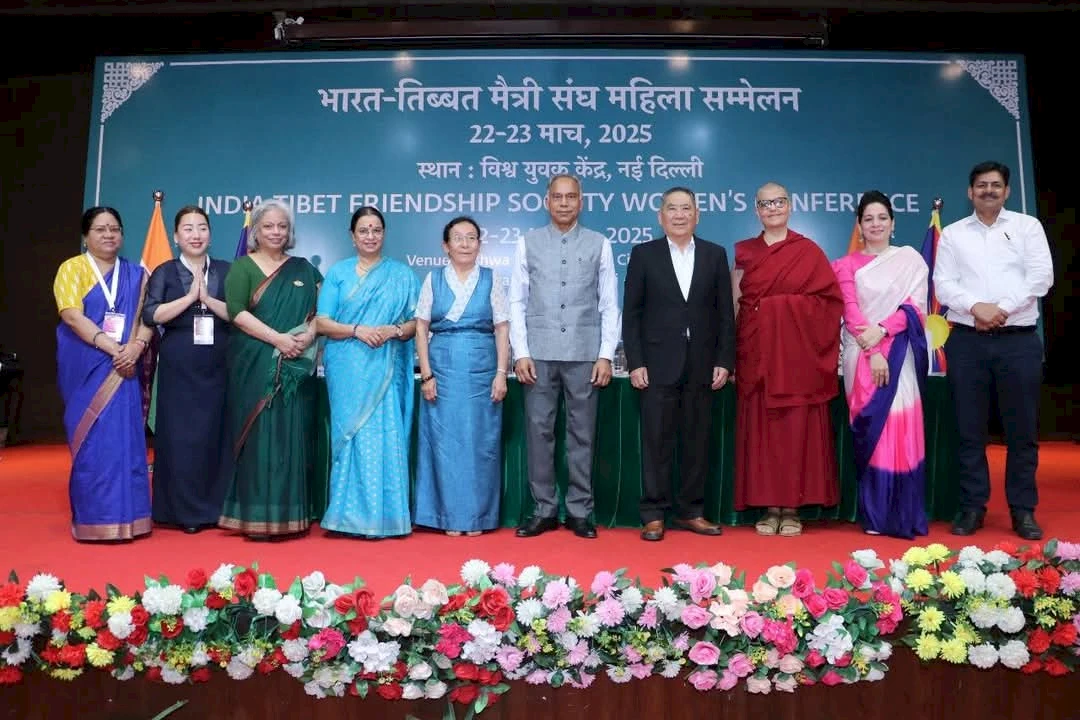
As the holder of the Dalai Lama Chair at Panjab University, she also delivered the Inaugural Lecture on the theme, ‘Relevance of the Buddhist Idea of Peace in Contemporary Times’ on 24 March.
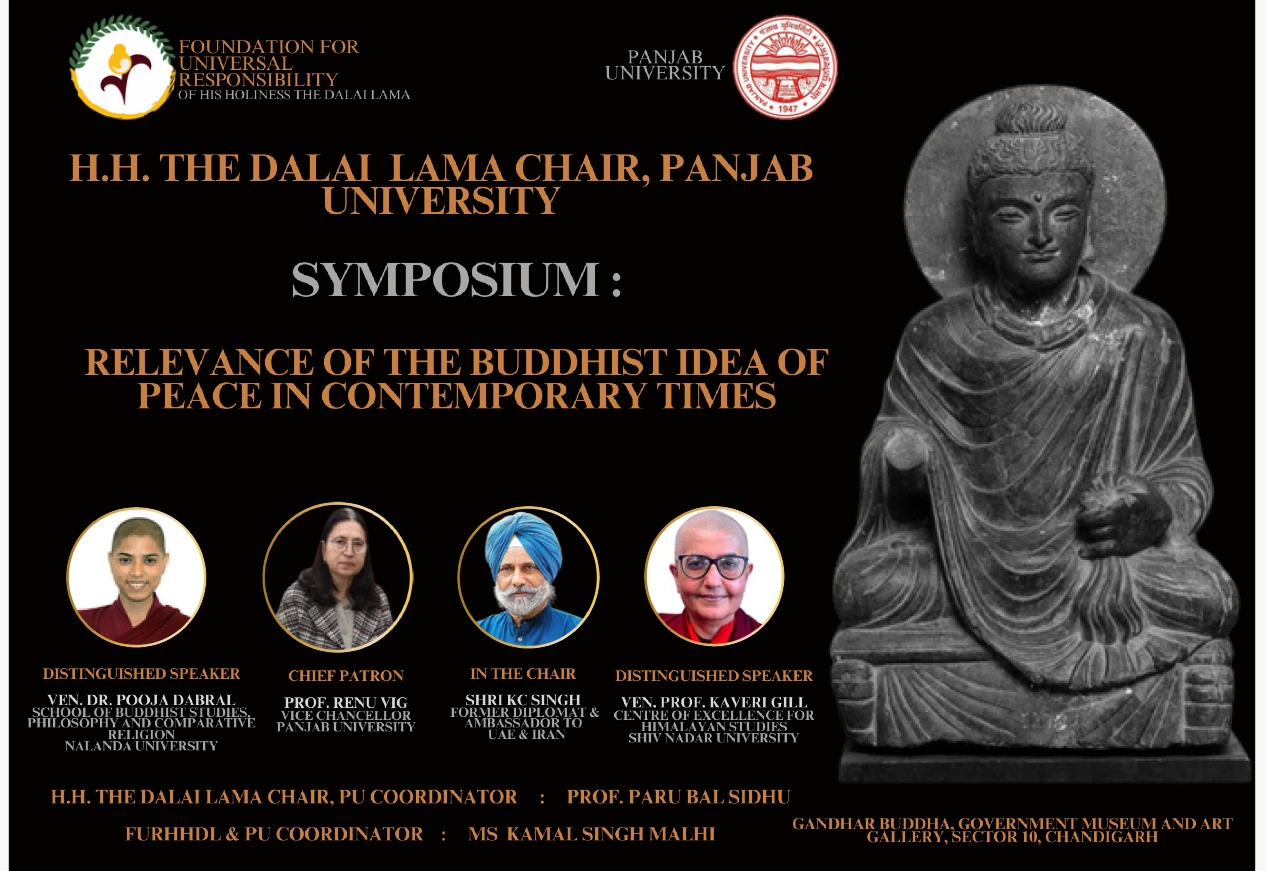
On 26 April, she delivered the Keynote Address at a conference on ‘Contemporary Trends in Psychotherapy: Mindfulness Based Practices and Schema Therapy’ for accredited psychotherapists and doctors, organised by Medanta Hospital, Gurugram.
CHS Postdoctoral Fellow, Dr Kalzang Dorjee Bhutia led a workshop called ‘Circulating Knowledge through the Air and Land Workshop’ at Occidental College, Los Angeles, USA on 10 April.
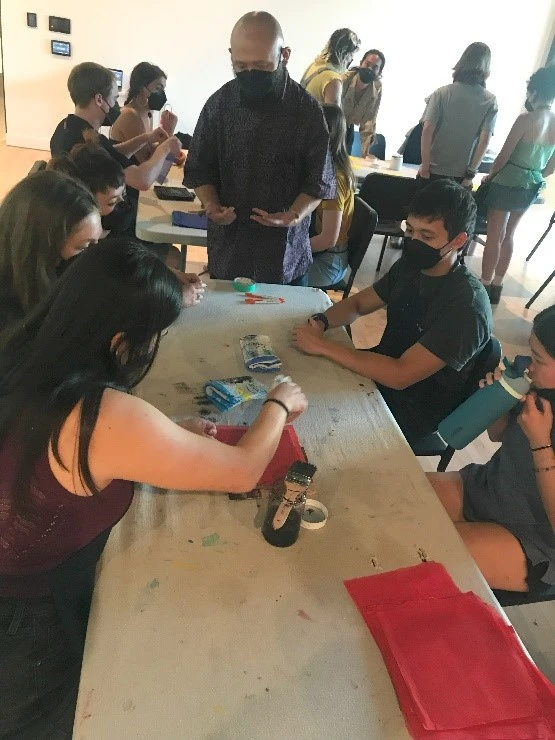
Dr Anand P. Krishnan was a panelist in a roundtable titled ‘China’s Private Sector and Increasing Vote of Confidence from the Party-State’ organised by the Institute of Chinese Studies, Delhi in April.
CHS Post-Doctoral Fellow, Dr Rimi Tadu presented her paper, ‘The Act of Remembering: Local History of India-China War of 1962’, at a national seminar hosted by the History Department, Rajiv Gandhi University, Doimukh. She also visited Kaho village (the last village near the China border) and Walong village in Arunachal Pradesh for her field work, interacting with members of the Meyor community.
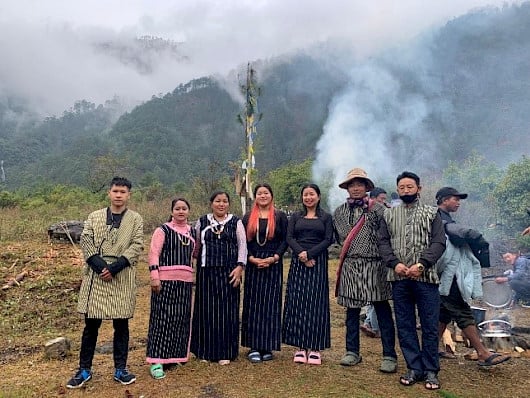
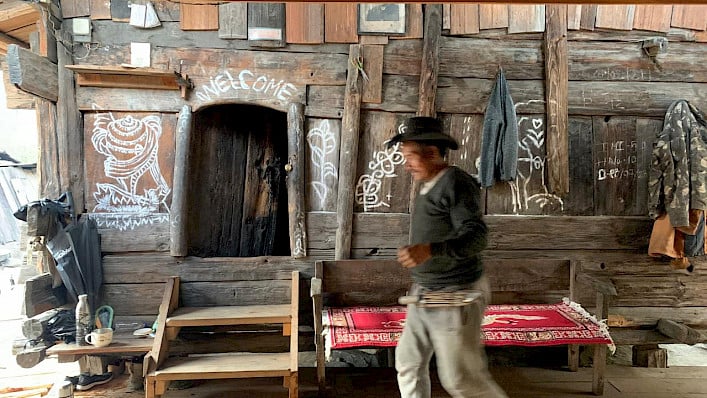
The Meyor community in Walong, Arunachal Pradesh
CHS Post-Doctoral Fellow, Dr Sangay Lachenpa also conducted fieldwork in North Sikkim, documenting the annual Buddhist ritual mask dance performed by the local Bhutia community, who gather as members of the traditional institution of Dzumsa. The mask dance is a significant ritual for the community, serving as an assertion of their religious practices and cultural identity reflecting the deep interconnection between their spiritual practices and cultural heritage.
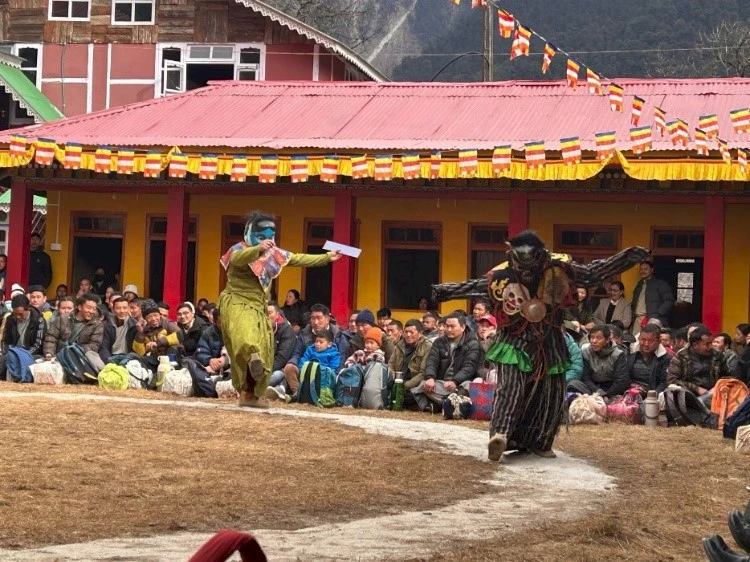
You can stay updated with our publications, events, and activities through our website, X (@Himalayas_SNU), Facebook, and LinkedIn. You can also find previous Newsletters on our website.
Share this: